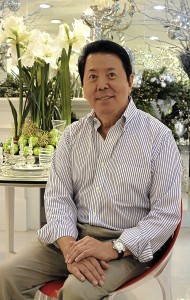
The first thing he did was to downplay the objects that made his eyes roll.
At Rustan’s Tower, for instance, the clichéd capiz handicrafts were de-emphasized to highlight objets d’art. At Rustan’s Makati, he sent the polar bears to the fifth floor and ordered metallic strips to cascade like icicles on Christmas tree branches.
For OVO, his advocacy is to give the brand a strong identity and a world-class image by integrating his luxury products.
Antonio’s style is influenced by his pedigree. His father was National Artist for Architecture Pablo Antonio, while his mother, Marina, was a couturier and style arbiter in the ’50s.
In the ’70s and ’80s, he set the trend of replacing heavy adobe masonry with ivory Mactan stone and popularized Modern Asian interiors.
Over a decade ago, Chito (who is sometimes mistaken for his younger brother, architect Ramon) caught media attention for his association with client former President Joseph Estrada. Antonio not only designed his residence and the Malacañang Premier Guesthouse, but he also taught Estrada’s household the art of graceful hospitality.
Artisan products
Zenaida R. Tantoco, Rustan’s Commercial Corp. president, invited him to design the new OVO boutique at Newport City and develop its products.
“Those mother-of-pearl objects are a dime and a dozen,” he says. Hence, Antonio collaborated with his longtime artisan from Bangkok to produce Art Deco-ish sterling silver picture frames, gilt and silver-leaf coolies, and delicate nacre serving dishes.
He teamed up with Cebu-based businesswoman Gladys Dueñas-Uy to produce shagreen products such as placemats, evening clutches, trays and utility boxes in Armani colors such as taupe, khaki, ecru, brown and black, edged with bone.
“I’m veering away from the compartmentalized jewelry boxes,” he says. “Men also like boxes.”
Through the years, he collected thick nacres which have been made into plates for caviar or truffles. The embellishments are done in sterling silver, unlike other less expensive counterparts which use thinner shells and silver-plated brass motifs. Through time, the latter will chip away and the silver-plating will tarnish.
“Even if my products are a bit pricey, they’re for keeps,” Antonio maintains.
The purses and minaudieres are named MRA, an homage to his mother Marina Reyes Antonio. When she was alive, he would use her brooches and jewelry to adorn her evening purses.
For OVO, the minaudieres are more resplendent, resembling big brooches. Not compromising on quality, Antonio sourced baroque and South Sea pearls from China, Japan and Australia, and clustered them with peridot, topaz, onyx, amethyst and citrine. The patterns look like little bumblebees and flowers, perched on honeycombs.
It was a reference to his mother’s love for bumblebee jewelry. “My mom would tell me little details like leaving some space in the purse to place her thumb,” Antonio adds.
The Chinoy collection is a reference to the Sangleys during the Spanish period. They are made of 24k gold leaf for OVO, combined with faux alligator leather. The figurines serve as salt and pepper holders, bookends and candleholders.
Antonio likens OVO’s re-imaging to that of Shanghai Tang, whose main design concept was based on local tradition, infused with dynamism and currency. Like other global brands associated with a national aesthetic, he hopes OVO would embody the Filipino sophistication born out of its multicultural influences.
Memories of mother
From product development, Antonio’s job evolved into styling sections of Rustan’s and amping up the visual merchandising in the home area. For the Inquirer Lifestyle pictorial, he created two table settings that again evoked memories of his mother at Christmas.
“The Christmas table was a buffet of Virginia or Chinese ham, turkey. My mother never liked stuffing it. They were either in a timbale or baked in a bowl. Instead of relleno, she served galantina. She loved green, seedless grapes, which was my idea for this table setting.”
At Rustan’s Makati, the Noche Buena table setting is cool and crystalline. A country table is given a sophisticated touch with a mirrored top and clear Philippe Starck Ghost chairs. Inspired by the eco-lifestyle, the centerpiece is a profusion of grapes dusted with gold, mixed with Christmas pines, silk leaves, silver cones and gilt, and silver balls.
While green dominates, the supporting color is powder blue, which is used in placemats. Its metallic threads highlight the iridescent handles of the cutlery. For contrast, he used graduating tones of china in ivory, cappuccino and beige from Monique Lhuillier’s point d’esprit collection.
The delicate pearlescent gray borders on the china pick up the metallic sheen of the rest of the decor. Tapered candles on glass candlesticks add drama.
The festive energy is reflected in the glasses etched with swirls and twirls and angels in candleholders. The table is adorned with little metallic Indian spires and purple flowers. An all-white floral centerpiece of lilies, on a silver plate, cushioned by matte and shiny green balls, anchors all the elements
Antonio points out that one need not use expensive objects. At Rustan’s Tower, Antonio created a table setting using bamboo-patterned plates and flatware with coco lumber handles. Although they are modestly priced, they look rich when set atop a placemat made of polished, spotted shagreen, the rawhide from stingray, and juxtaposed with Schott Zwiesel stemware and his silver-leaf coolies that double as candleholders.
The title “creative director” has yet to be conferred. Still, Antonio looks at his new endeavor as an outlet for his artistic expression. His work isn’t about selling a lifestyle, which most shoppers of Rustan’s already have, but more of reminding them of a life with style.